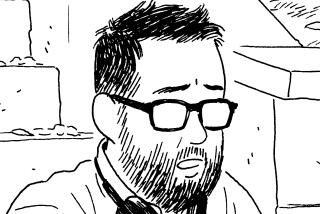An Alternative Cartoonist Who Draws the Line
- Share via
His syndicated comic strip called “Life in Hell” stars three pathological rabbits and two fez-wearing gay businessmen.
His three lines of greeting cards include a collection of covers for fake magazines, such as Today’s Misery (with an articles on “What to Do With All That Extra Room in Bed”) and a group of phony movie posters, including “Young Republicans Go Shopping.”
For the record:
12:00 a.m. Aug. 26, 1987 For the Record
Los Angeles Times Wednesday August 26, 1987 Home Edition View Part 5 Page 2 Column 3 View Desk 1 inches; 21 words Type of Material: Correction
In an Aug. 23 article on alternative cartoonist Matt Groening, an incorrect location was given for The Evergreen State College. It is in Olympia, Wash.
Most recently, he began working in animation: 15-second segments featuring “a mutant-’50s-Father-Knows-Best Family in Hell” sprinkled throughout the Fox Network’s “The Tracey Ullman Show.”
Thirty-three-year-old Matt Groening is the rambunctious, unpredictable, taboo-defying alternative cartoonist who makes Garry Trudeau’s “Doonesbury” seem, by comparison, reminiscent of “Mary Worth.”
His weekly strip is now run in more than 60 newspapers, mostly college papers and alternative weeklies.
While Groening continually tests the limits of modern taste, much of his humor is inoffensive, like this counsel to the lovelorn from “Life in Hell”: “If you’re going to argue with your partner at a restaurant, make it a cheap one, because you won’t be tasting your food anyhow.”
The cartoon’s language, which once included every contemporary expletive, has been cleaned up enough that two daily papers, the San Francisco Examiner and the (Portland) Oregonian now run the strip. But even so, the cartoonist notes with amusement, the Oregonian initially asked to change “Life in Hell” to “Life in Heck.”
In person, Groening is even more surprising than the whacked-out hellions for which he’s increasingly well known.
Here in his self-described “bat cave/teen-age clubhouse”--actually the garage-turned-studio of his new home located on a Venice canal--the man is relentlessly pleasant. Meeting him is like encountering the Pillsbury Doughboy after expecting an overbaked Cookie Monster.
This afternoon, Mr. Hell himself, a happily married newlywed wearing baggy shorts, a plaid shirt, big glasses and sandals, is lunching on Pollo Loco leftovers. And waiting for his MacIntosh to print out a script for an animated episode.
An unquestionably gentle soul, Groening is telling great stories, among them a revealing tale of how he became so fond of the canal ducks that when nearly all of a mother duck’s newborn babies died, he drove to the Red Wing Hatchery in Huntington Beach to buy her seven new ducklings.
Ducks Are Next
But don’t bet on that showing up in one of his cartoons. He eventually plans to use the ducks, but in a strip or book titled (what else?) “Ducks Are Hell.”
His previous books are “Love Is Hell,” “Work Is Hell” and “School Is Hell,” recently published by Pantheon Books with a 75,000-copy first printing.
Ask Groening about the apparent dichotomy between his outer work and his inner nature, and he replies that many other people have noticed it too.
Says Wendy Wolf, his Pantheon editor: “You expect to meet some wizened little creature in a dark room. But he’s very outgoing, very affable. While he associates with an avant-garde world, he actually writes about things that are the heart of everyday experience. I once accused him of having a direct line into the collective unconscious of the Baby Boom generation.”
James L. Brooks, producer/director/writer of “Terms of Endearment” and one of the executive producers of “The Tracey Ullman Show,” has been a longtime Groening fan who’s also noticed the contrast.
“Maybe there’s something in one that relaxes when you see the truth,” Brooks speculates.
Groening, however, isn’t buying any disparity.
The Real World’s Worse
“There’s no contradiction,” he contends. “My stuff may be dark and cynical to some people, but I think it’s a fairly optimistic view of the world. The world is a much worse place than ‘Life in Hell.’ ”
Much of Groening’s humor springs from his history as a childhood troublemaker in Portland, Ore., where he attended “regular, fascist, American public schools.”
“I could understand getting sent to the principal’s office for dropping an encyclopedia out the window,” he reasons now, “but I couldn’t understand them ripping my cartoons up.”
The son of an advertising man-turned-film maker and a grade-school teacher-turned-mother of five, Groening managed to graduate from high school and Portland’s The Evergreen State College, an alternative school with no required courses, no tests and no grades.
At Evergreen, he essentially studied film making, journalism, philosophy and pop culture. His garage/studio/cave/clubhouse--loaded with obscure books, comics and record albums “guaranteed not to be found in any library”--practically screams that those studies have never ended.
Fellow alternative cartoonist Lynda Barry, who produces a syndicated weekly strip and a monthly cartoon for Esquire, first met Groening when they were both students at Evergreen.
Today, her books always carry an acknowledgment of Groening as “Funk Lord of the U.S.A.” and his, in turn, have referred to Barry as “Funk Queen of La Bufadora,” “Funk Queen West of the Rockies” and “Funk Queen of the Galaxy.”
But their friendship wasn’t always so tight. As Barry recalls, he was the editor of the school paper and he ran with a pretty hip crowd. “I was fascinated by the fact that he’s very easily irritated and so I irritated him a lot. I had no control. . . .
“Matt used to do this thing where when he didn’t want you to talk to him, he’d wear this antenna on his head (made of a coat hanger), which to me was like a red cape to a bull.”
After graduation from Evergreen in 1977, Groening headed for Los Angeles and had such lousy experiences that he started cartooning letters called “Life in Hell” for his friends back home.
While he struggled with early jobs, such as ghostwriting an autobiography for a forgotten 88-year-old Hollywood producer, Groening continued to hone his cartoon style.
A Variety of Jobs
Later in his first year in Los Angeles, he joined the staff of the Reader, a free Los Angeles weekly paper, and held jobs ranging from music columnist to paper deliverer to associate editor.
His cartoons were first published in the ultra-trendy WET magazine in 1978. Two years later, “Life in Hell” began regular appearances in the Reader, which Groening says he left in 1984 because of “contract difficulties.” The cartoon now appears in L. A. Weekly.
At the Reader, Groening met sales manager Deborah Caplan, whom he married last October (the miniature couple atop their wedding cake were two of the rabbits from “Life in Hell,” Binky and Sheba, Binky’s estranged girlfriend.)
Groening credits his wife with much of his success, and for resigning from the Reader to manage his career.
“Basically, I started by getting his basics together, getting him out of a horrible part of Hollywood into a beach area and finding ways to market the cartoon and his talents,” Caplan says. “He actually saw a nice fee come in (from sidelines such as greeting cards) and realized he didn’t have to be a starving artist.”
Spinoffs to the Strip
Caplan and Groening then formed Acme Features Syndicate which now employs three workers besides themselves to market the strip and spinoffs such as T-shirts, mugs and calendars.
Meanwhile, Groening’s books are selling so well in English-speaking countries that inquiries are coming in concerning translations in Greek, French and Japanese.
Might all this success temper the angry youth who speaks in the cartoons? Might the edge somehow be softened as more and more straight publications pick up Groening’s work?
“As I get older, no doubt I will get crankier,” he predicts. “I don’t expect to change the title of the strip to ‘Life Is Swell’ in the foreseeable future.”
Prodded, however, Groening admits he has been asked to tone down elements in his animated work.
“A few of my cartoons have received letters of protest and I’ve been asked to knock off certain violent tendencies . . . . It was OK to have a baby fall down some stairs, but having her stick a fork in an electric outlet proved to be too much. But that wasn’t anything that hasn’t happened to Wylie Coyote or Donald Duck.”
Caplan is even more convinced that success will not sap her husband’s inclination to challenge traditional media standards.
As she puts it, “He’s so neurotic, I don’t think his edge will ever get softened.”
More to Read
The biggest entertainment stories
Get our big stories about Hollywood, film, television, music, arts, culture and more right in your inbox as soon as they publish.
You may occasionally receive promotional content from the Los Angeles Times.










